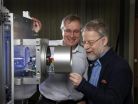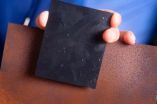(Press-News.org) Laser systems can be used to implement highly precise and ultra-fast measuring processes. Railway measuring technology has a huge worldwide need here. One prerequisite for its use is that nobody is damaged or suffers irritations by the laser. Dr. Heinrich Höfler and Dipl.-Ing. Harald Wölfelschneider from the Fraunhofer Institute for Physical Measurement Techniques IPM in Freiburg have worked with their team to develop a 3D laser scanner. It can be used outdoors without hesitation. Extremely fast and precise, it is able to spatially measure and monitor the position of the contact wire or the track from a train travelling at up to 100 kilometers (62 mph) per hour. If the scanner is stationary, it can capture passing trains and check for loads that might have slipped.
Heinrich Höfler explains how that works: "We send off a laser beam and wait until it returns. We measure the time in between and that tells us how far away an object is." The difficult part is capturing the returning beam. Often, only very little light comes back and what's more, the transmitted light beam is back in an extremely short space of time. The solution: A kind of slow motion. The laser beam is very rapidly switched on and off – modulated, as scientists would put it. The time shift of this modulation wave can be determined more quickly and precisely than is possible with a single laser pulse.
Capturing obstacles and constrictions during movement
The system measures, by default, one million times per second. "For Deutsche Bundesbahn (German Railway), we equipped a measurement train that scans the surroundings of the test track, using several laser beams and which delivers, taking four million measurements per second, a 3D image of what it scans", explains Harald Wölfelschneider. That allows even small obstacles and constrictions to be detected, or we can plan the route via which a heavy load can best be transported to its destination.
Another field of application is the measuring of passing trains. This requires the scanner to be permanently mounted, which, however, does increase the chance of someone looking into the laser beam for a longer period. To make the scanner safe for the human eye, the researchers had to develop a new wavelength range: infrared, which is harmless for our eyes. The consequence being that the entire system had to be fully reconfigured.
From railway to road – in global use
If we examine railways carefully, it makes sense that we then also examine other traffic routes, such as roads. The team at IPM has developed a 3D scanner, safe for the human eye, which is mounted onto a moving car and which scans the road from a height of about three meters. "We can now detect height differences of even 0.2 millimeters on the road, even at speeds of 80 kilometers per hour (approx. 50 mph)", says Höfler. This is the first scanner approved for this purpose by the Federal Highway Research Institute. It is to detect lane grooves, potholes and water drainage potentials.
The laser system has already been marketed and used successfully all over the world for rail traffic safety. Not only fast and precise, this system is also highly robust. Dr. Heinrich Höfler and Dipl.-Ing. Harald Wölfelschneider will receive one of the 2012 Joseph-von-Fraunhofer awards for this eye-safe 3D laser scanner.
INFORMATION:
Laser scan at full speed
2012-05-21
ELSE PRESS RELEASES FROM THIS DATE:
Bridesandlovers.com Bring More Happy Couples Together
2012-05-21
Bridesandlovers.com - the premier Russian dating and marriage agency for men seeking relationships with Russian and Ukrainain women - Today announced that it has broken its previous record for success stories in April 2012. By bringing to the point where over 30 online couples involved in a internet relationship have taken the relationship to something more stable and permanent often making a planned trip to meet each other in real life. Bridesandlovers.com broke their previous record set in September of last year. Customer feedback has showed the couples used the features ...
Dartmouth researchers investigate the cognitive effects of athlete head impacts
2012-05-21
Dartmouth faculty and students played prominent roles in a recent study on the cognitive effects of head impacts among student athletes. Tested at the beginning and end of one season, 22 percent of those students who participated in contact sports scored significantly lower in memory and learning skills than expected, as opposed to only 4 percent of non-contact sport athletes.
"These results were found shortly after the season and we do not know how long the effect [of the head impacts] lasts," said Thomas McAllister, Millennium Professor of Psychiatry and Director of ...
New silicon memory chip developed
2012-05-21
The first purely silicon oxide-based 'Resistive RAM' memory chip that can operate in ambient conditions – opening up the possibility of new super-fast memory - has been developed by researchers at UCL.
Resistive RAM (or 'ReRAM') memory chips are based on materials, most often oxides of metals, whose electrical resistance changes when a voltage is applied – and they "remember" this change even when the power is turned off.
ReRAM chips promise significantly greater memory storage than current technology, such as the Flash memory used on USB sticks, and require much ...
Facebook and smartphones: New tools for psychological science research -- news brief
2012-05-21
WASHINGTON — Whether you're an iPerson who can't live without a Mac, a Facebook addict, or a gamer, you know that social media and technology say things about your personality and thought processes. And psychological scientists know it too – they've started researching how new media and devices both reveal and change our mental states.
Two recent articles in the journal Perspectives on Psychological Science, a publication of the Association for Psychological Science, explored how trends in technology are changing the questions psychological scientists are asking and the ...
Using graphene, scientists develop a less toxic way to rust-proof steel
2012-05-21
BUFFALO, N.Y. -- University at Buffalo researchers are making significant progress on rust-proofing steel using a graphene-based composite that could serve as a nontoxic alternative to coatings that contain hexavalent chromium, a probable carcinogen.
In the scientists' first experiments, pieces of steel coated with the high-tech varnish remained rust-free for only a few days when immersed continuously in saltwater, an environment that accelerates corrosion.
By adjusting the concentration and dispersion of graphene within the composite, the researchers increased to about ...
Hadley Nursing Center Teams with Martin Luther King Jr. Elementary School for Healing Walls Project
2012-05-21
The Hadley Nursing Center at the Specialty Hospital Of Washington (SHW), joined forces with 4th and 5th grade students at Martin Luther King Jr. Elementary School in the Healing Walls Student Art Exhibit.
The Healing Walls project was developed by Cheron McNear, Marketing Coordinator for Specialty Hospital of Washington, and is designed to provide the patients and residents in our facility with uplifting artwork that will inspire and assist them in their healing process. The students were led by their art teacher, Mr. Bryan, who directed the theme of the artwork around ...
Richard Knapp Wins the Screenplay Competition at the 2012 Canada Film Festival
2012-05-21
Andre' Haynes 'The People's Publicist' announced today that Richard Knapp of Las Vegas, NV has won the Award of Excellence of the Screenplay Competition at the 2012 CIFF, for his screenplay, "Can Richard Come Out and Play?". Richard Knapp's Award of Excellence was presented on March 31, 2012 at the Closing Night Award Ceremony at Edgewater Casino's Stadium Club Theatre.
CIFF is gaining a reputation for its wide variety of film genres, and has quickly garnered a respected following for its dynamic selections. Held each year in Vancouver, BC, the festival brings ...
Production of chemicals without petroleum
2012-05-21
In our everyday life, we use gasoline, diesel, plastics, rubbers, and numerous chemicals that are derived from fossil oil through petrochemical refinery processes. However, this is not sustainable due to the limited nature of fossil resources. Furthermore, our world is facing problems associated with climate change and other environmental problems due to the increasing use of fossil resources. One solution to address above problems is the use of renewable non-food biomass for the production of chemicals, fuels and materials through biorefineries. Microorganisms are used ...
UGA study finds that education plays mitigating role in escaping roots of adversity
2012-05-21
Athens, Ga. – Decades of research show people born into poverty are likely to continue to live that way as adults. But one University of Georgia researcher has found a way out—education.
Children reared in disadvantaged communities and poor families earn less money and experience more health problems as adults than do children raised without adversity, according to Kandauda Wickrama, a professor of human development and life science in the UGA College of Family and Consumer Sciences.
"Early adverse life experiences, such as community or family poverty, have a detrimental ...
A North American first at the Montreal Heart Institute
2012-05-21
Montreal, May 18, 2012 – The surgical team at the Montreal Heart Institute (MHI) achieved a North American surgical milestone on May 1st with a sutureless aortic valve replacement through a thoracic incision just five centimetres long. The two patients in their seventies who underwent this innovative procedure, which was performed by cardiac surgeons Denis Bouchard and Michel Carrier, were doing well only one week after their operations.
A novel combination
"This innovative combination of implanting a Perceval™ S valve through a minimally invasive thoracotomy signals ...




